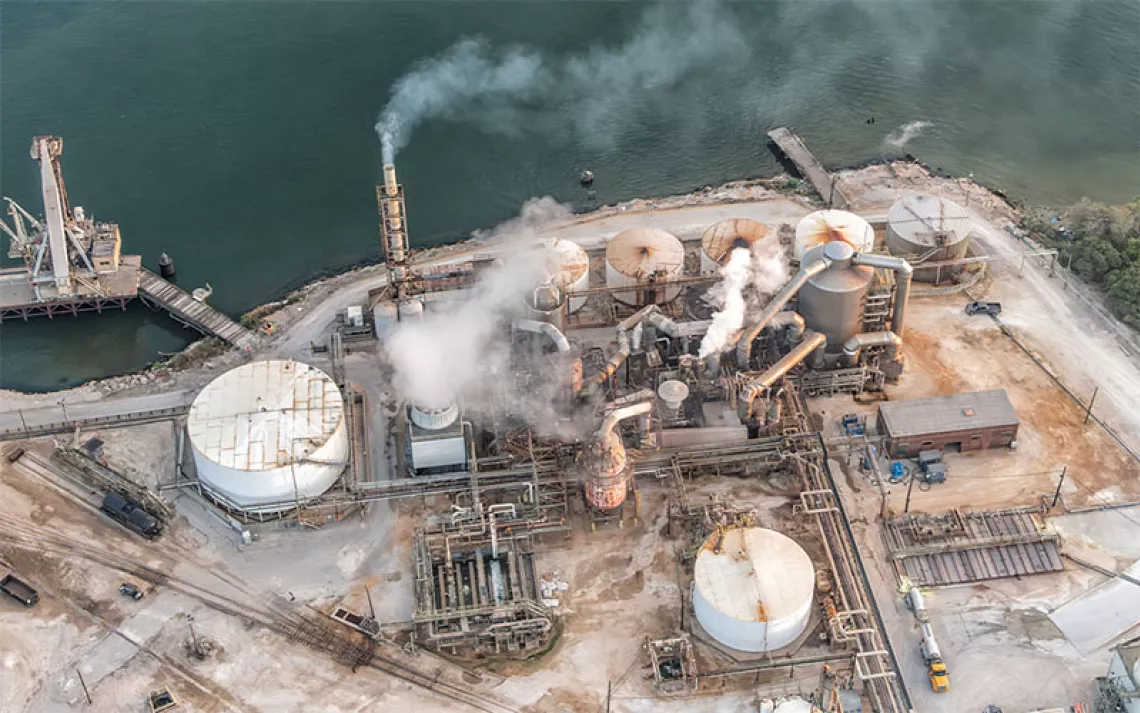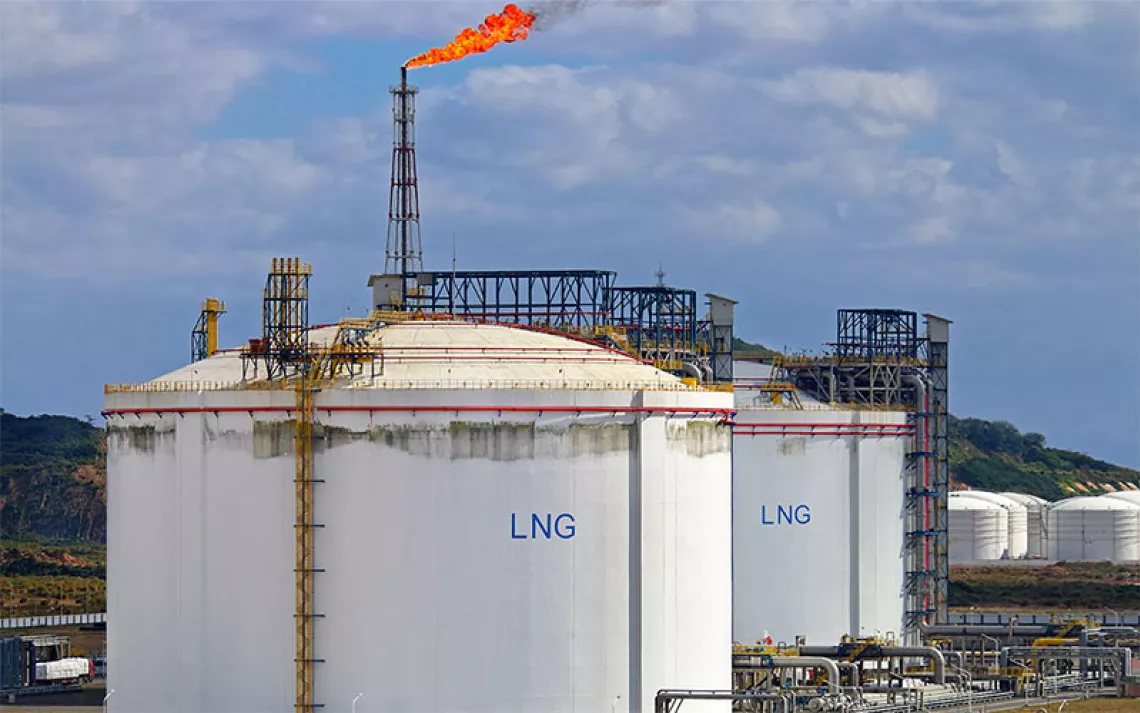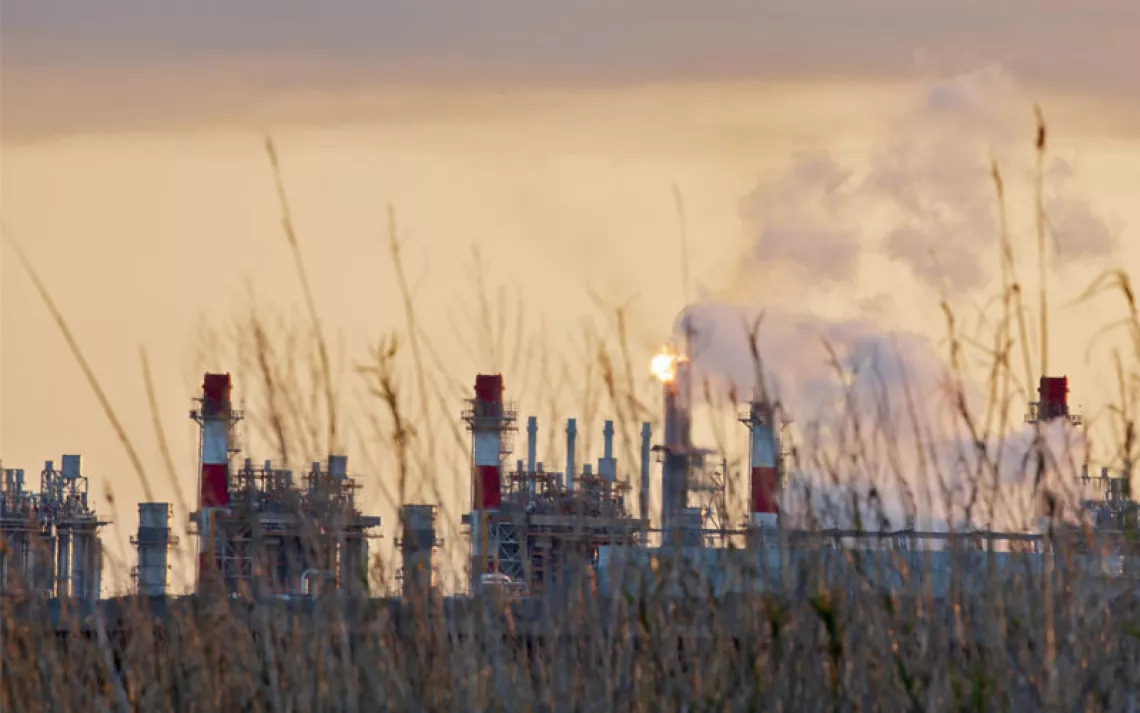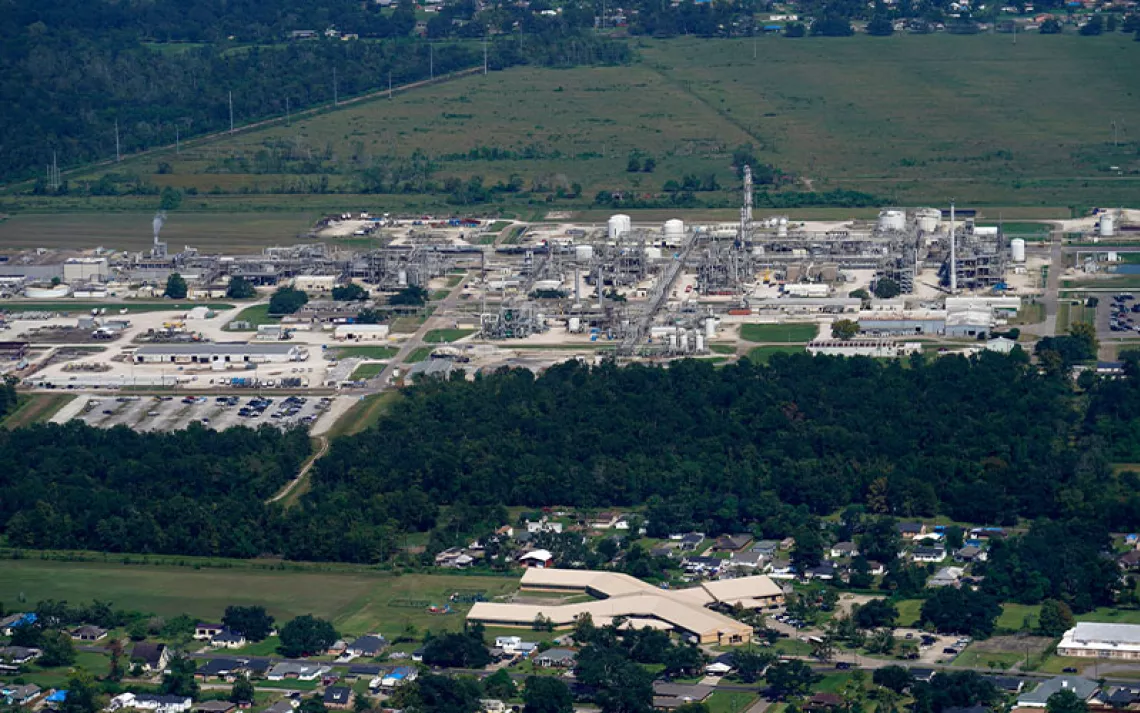Landowners, Environmentalists Unite to Stop Gas Export Facility
Fight over Coos Bay LNG terminal is latest "Keep It in the Ground" flashpoint
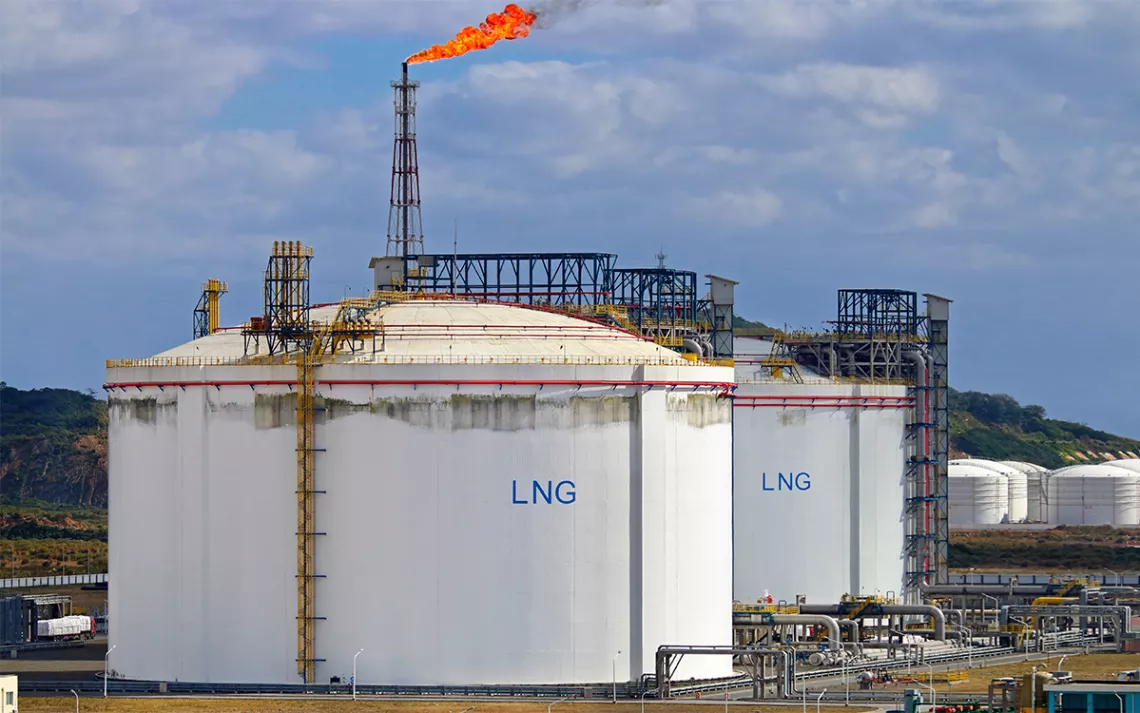
Coming soon to Coos Bay, Oregon? | Photo by Sky_Blue
Update: In May, the Oregon Department of Environmental Quality and Army Corps of Engineers opened a 60-day comment period for the Jordan Cove project's 401 Water Quality Certification application. This is an opportunity for the public to weigh in with specific concerns about the application. The agencies will use these comments to help develop a findings report and decide whether to award the certification. You do not have to be a resident of Oregon to comment. You can comment here.
When Clarence Adams learned that a Canadian company could use eminent domain to seize his land in order to move fracked gas through a pipe en route to Asia, he was outraged.
“I’ve spent 27 years trying to pay off my land,” says Adams, gesturing at the mature oaks and conifers gracing his eight-and-a-half-acre property outside of Tenmile, Oregon. “If there’s a break in that pipe and a fire, my house is toast.”
Adams is part of a stubborn contingent of holdouts who are refusing to sell easements for the Pacific Connector Gas Pipeline—a proposed gas conduit that, if built, would move fuel to Jordan Cove, a proposed liquefied natural gas (LNG) facility in Coos Bay, Oregon. Once there, the gas would be super cooled, loaded into tankers, and shipped to markets in Asia.
The project has met with fierce local resistance since it was first introduced in 2004 as an import project. When the North American fracking boom led to a glut of gas domestically, project planners flipped Jordan Cove into an export terminal—one of many LNG terminal projects proposed for the United States and Canada over the past several years. Opponents say the Pacific Connector pipeline route is ill considered. The proposed route crosses 400 known waterways and much of it is forested. The pipeline would require a 95-foot temporary and a 50-foot permanent easement along its length, and local residents say simply building it could degrade water quality and further fragment the forest.
The proposed Jordan Cove LNG terminal would be built on Coos Bay’s sandy north spit, well within the tsunami zone. Eighteen million cubic yards of sediment would be removed just to widen and deepen the channel, destroying clamming beds and fish habitat. If built, the LNG facility and supporting pipeline would help fuel global climate change, as they would incentivize the drilling of new gas wells in the American West and in Canada.
The nation is at a crossroads when it comes to new fossil fuel infrastructure. Since the headline-making protests of the Keystone XL and the Dakota Access Pipelines, citizens have signaled that they are no longer willing to sacrifice clean water, property rights, and a stable climate for the benefit of oil and gas corporations and their shareholders. On the East Coast, opponents promise a storm of lawsuits against the controversial Atlantic Coast Pipeline. In Virginia, tree-sitters are preventing the tree-clearing required for the Mountain Valley Pipeline. And in the Southeast, legal challenges by the Sierra Club have kept the Sabal Trail Pipeline, which runs from Alabama to Florida, in a state of legal limbo.
In some cases, resistance has paid off. In 2016, Oregon LNG withdrew its application for an LNG export facility in Warrenton, on Oregon’s north coast. The decision came after strong opposition from a coalition of tribes, fishing groups, conservation organizations, and landowners, and not long after the City of Warrenton Hearings Officer rejected key permits for the project, citing potential negative impacts to salmon and public access. Several LNG projects proposed for British Columbia’s western coastline have also been canceled due to a combination of grassroots resistance and unfavorable market conditions.
The Jordan Cove LNG project, which includes both the Pacific Connector pipeline and the LNG facility, has already been stopped twice. In April 2012, the Federal Energy Regulatory Commission (FERC) vacated the order authorizing the project when the company announced it wanted to flip Jordan Cove from an import terminal to an export facility. Then, in March 2016, in an unprecedented decision, FERC denied the permit for the export project, stating that the public benefits of the project did not outweigh the negative impacts to landowners, whose property rights could be taken through eminent domain. The decision came thanks in large part to the refusal of so many landowners to sell their easements and the opposition from thousands of area residents, including ranchers, anglers, youth climate activists, Native American tribal members, and business owners.
But the victory was short-lived. In September 2017, Jordan Cove LNG submitted a new application to FERC.
“We have a very different FERC today,” says Stacey Detwiler, conservation director for Rogue Riverkeeper. With Trump appointees heading the agency, federal approval may be more likely this round. But, as Detwiler points out, the project must also acquire many state and federal permits from various agencies. One of the most critical of these is “401 certification” from Oregon’s Department of Environmental Quality, as required by the federal Clean Water Act. That certification must be accompanied by a “404 permit,” issued jointly by the federal Army Corps of Engineers and Oregon’s Department of State Lands, which regulates the discharge of dredged or fill materials.
Adams is skeptical that the company is taking all of the potential impacts into account; for example, on his property, the path cleared for construction will affect a nearby creek. “When construction’s over, the trees shading the creek will still be gone,” he says.
The fears about water quality impacts are not merely speculative. For example, the Rover Pipeline, which is being constructed to carry 3.25 million cubic feet of natural gas daily from the Marcellus and Utica shale beds to Michigan, has been plagued with problems. Construction has been halted twice, and in November of 2017, the state of Ohio sued Rover Pipeline LLC over its numerous water quality violations, which include discharging 2 million gallons of drilling fluid into a wetland.
While many of the landowners, Native American nations, and conservation groups are focused on direct impacts such as safety, impacts to cultural resources, and the use of eminent domain, groups such as Rogue Climate point to the larger implications of new fossil fuel infrastructure. They argue that the Jordan Cove project takes Oregon farther away from its stated commitments to reduce greenhouse gas emissions.
When combusted in new, efficient facilities, gas releases half as much carbon dioxide as the typical new coal-fired plant. Recent research, however, has revealed that gas is not as clean as touted, especially when produced through methods such as hydraulic fracturing. Fracking wells leak methane, a potent greenhouse gas, and studies have shown that the leakage rates at these wells are higher than previously thought. NASA released a report that showed that the global spike in methane emissions since 2006—a spike that corresponds with the North American fracking boom—is largely due to increased emissions from the oil and gas industry.
In January, the fossil fuel watchdog group Oil Change International released a life-cycle emissions analysis on the Jordan Cove project. The report claims that, assuming a conservative methane leakage rate of 1.77 percent, the project would result in annual emissions of 36.8 million metric tons, making it the largest emitter in the state of Oregon.
Opponents of the Jordan Cove project are steeling themselves for a long fight. According to Hannah Sohl, director at Rogue Climate, more than 400 groups and individuals have filed motions to intervene in the FERC process, giving them the right to request hearings and appeal final decisions.
Adams and his fellow holdouts face a formidable opponent. Pembina Pipeline Corporation acquired Veresen, Inc. in October 2017, a merger that created one of the largest energy infrastructure companies in Canada. Last year, the company spent over half a million dollars to defeat a Coos County initiative that would have effectively prohibited the Jordan Cove project and other "non-sustainable energy systems" within the county. Pembina has earmarked $135 million to propel the Jordan Cove project forward.
The company has convinced labor unions and local politicians that the project will bring jobs and investment into Oregon’s depressed south coast communities. To sweeten the deal, Jordan Cove LNG has begun handing out $60,000 in community improvement grants in the four nearby counties and is also financing a Combined Services Unit in the Coos County sheriff’s department.
The next move in this chess game will come when FERC releases a draft environmental impact statement for both the terminal facility and the pipeline. Larry Mangan, a retired wildlife biologist whose property is on an alternate pipeline route, points out that solving one problem often creates another. In the latest application, part of the route near Coos Bay was moved to a ridge to avoid impacting several landowners’ properties, including Mangan’s.
“The proposed route doesn’t cross as many streams and coho habitat as the alternative route, but it has marbled murrelets and spotted owls,” says Mangan, who isn’t assuming his property is out of harm’s way. “The company doesn’t have the final say; FERC does.”
The landowners are determined to fight the project to the end, and they understand the importance of a united front. “There’s some environmental folks I never thought I’d be on the same side of,” admits Adams, who started Landowners United to organize other affected landowners. “We have different opinions about what’s important and what to emphasize, but it all boils down to the same goal: Stop the pipeline.”
 The Magazine of The Sierra Club
The Magazine of The Sierra Club
